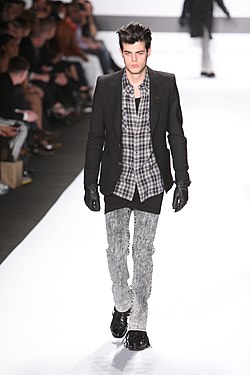Related terms

Over the course of the following years, other terms countering or substituting for "metrosexual" appeared.
- Retrosexual: It meant anti- or pre-metrosexual sense. [19] Later on, the term was used by some to describe men who subscribed to what they believed to be the grooming and dress standards of a previous era, such as the handsome, impeccably turned-out fictional character of Donald Draper in the television series Mad Men , itself set in the early 1960s New York advertising world. [20]
- Ubersexual: A term coined by marketing executives and authors of The Future of Men. [21]
- Spornosexual: A term blending sports, porn, and sexual. In 2016, Simpson argued that footballer Cristiano Ronaldo represents "a fusion of sport and porn [...] Cultivating an athletic body as an object of desire, and showing it off on social networks, accumulating sexual partners. It's a tendency with young men." [18]
- Technosexual: A term that circulated in media, fashion, and online outlets of the 2000s [22] to describe a male that possesses a strong aesthetic sense and a love of technology. [23] Swedish footballer Freddie Ljungberg is often cited as the perfect example of a technosexual man, due to an image of masculine sensuality and tech savviness. [24] [25] [26] [27] [28]
- Lumbersexual: In 2016–2017, the "lumbersexual" term circulated in media, fashion, and online outlets, describing a type of male aesthetics that use outdoor gear for urban aesthetics rather than function. [6]
- Female metrosexual: Although the term refers mostly to men, a discussion exists on whether women can be metrosexuals. [29] Characters from the HBO series Sex and the City have been described as wo-metrosexuality to illustrate how the metrosexual lifestyle de-emphasizes traditional male and female gender roles.
- Performative male: Also known as the matcha man, performative males consume traditionally female media, fiction, and food to attract attention from women. The Times likened them to "the modern metrosexual". [30]
Changing masculinity

Traditional masculine norms, as described in psychologist Ronald F. Levant's Masculinity Reconstructed are: "avoidance of femininity; restricted emotions; sex disconnected from intimacy; pursuit of achievement and status; self-reliance; strength; aggression and homophobia". [31]
Various studies, including market research by Euro RSCG, have suggested that the pursuit of achievement and status is not as important to men as it used to be; and neither is, to a degree, the restriction of emotions or the disconnection of sex from intimacy. Another norm change supported by research is that men "no longer find sexual freedom universally enthralling". Lillian Alzheimer noted less avoidance of femininity and the "emergence of a segment of men who have embraced customs and attitudes once deemed the province of women". [32]
Men's fashion magazines—such as Details , Men's Vogue , and the defunct Cargo —targeted what one Details editor called "men who moisturize and read a lot of magazines". [33]
Changes in culture and attitudes toward masculinity, visible in the media through television shows such as Queer Eye for the Straight Guy , Queer as Folk , and Will & Grace , have changed these traditional masculine norms. Metrosexuals only made their appearance after cultural changes in the environment and changes in views on masculinity.[ citation needed ] Simpson said in his article "Metrosexual? That rings a bell..." that "Gay men provided the early prototype for metrosexuality. Decidedly single, definitely urban, dreadfully uncertain of their identity (hence the emphasis on pride and the susceptibility to the latest label) and socially emasculated, gay men pioneered the business of accessorising—and combining—masculinity and desirability." [34]

But such probing analyses into various shoppers' psyches may have ignored other significant factors affecting men's shopping habits, foremost among them women's shopping habits. As the retail analyst Marshal Cohen explained in a 2005 article in the New York Times entitled, "Gay or Straight? Hard to Tell", the fact that women buy less of men's clothing than they used to has, more than any other factor, propelled men into stores to shop for themselves. "In 1985 only 25 percent of all men's apparel was bought by men, he said; 75 percent was bought by women for men. By 1998 men were buying 52 percent of apparel; in 2004 that number grew to 69 percent and shows no sign of slowing." One result of this shift was the revelation that men cared more about how they look than the women shopping for them had. [12]
However, despite changes in masculinity, research has suggested men still feel social pressure to endorse traditional masculine male models in advertising. Martin and Gnoth (2009) found that feminine men preferred feminine models in private, but stated a preference for the traditional masculine models when their collective self was salient. In other words, feminine men endorsed traditional masculine models when they were concerned about being classified by other men as feminine. The authors suggested this result reflected the social pressure on men to endorse traditional masculine norms. [35]